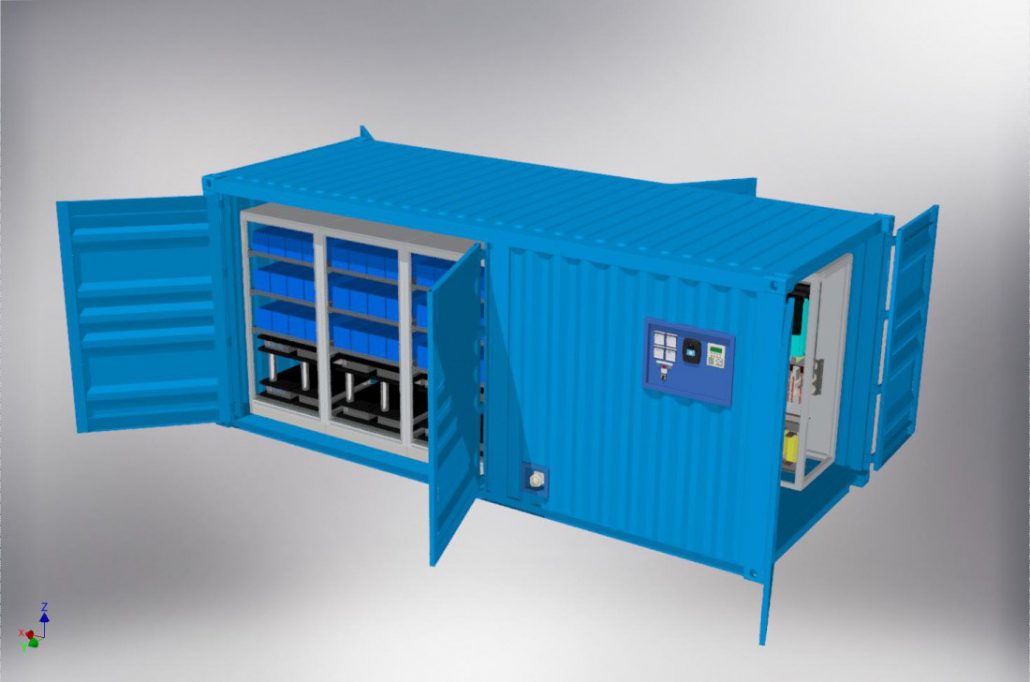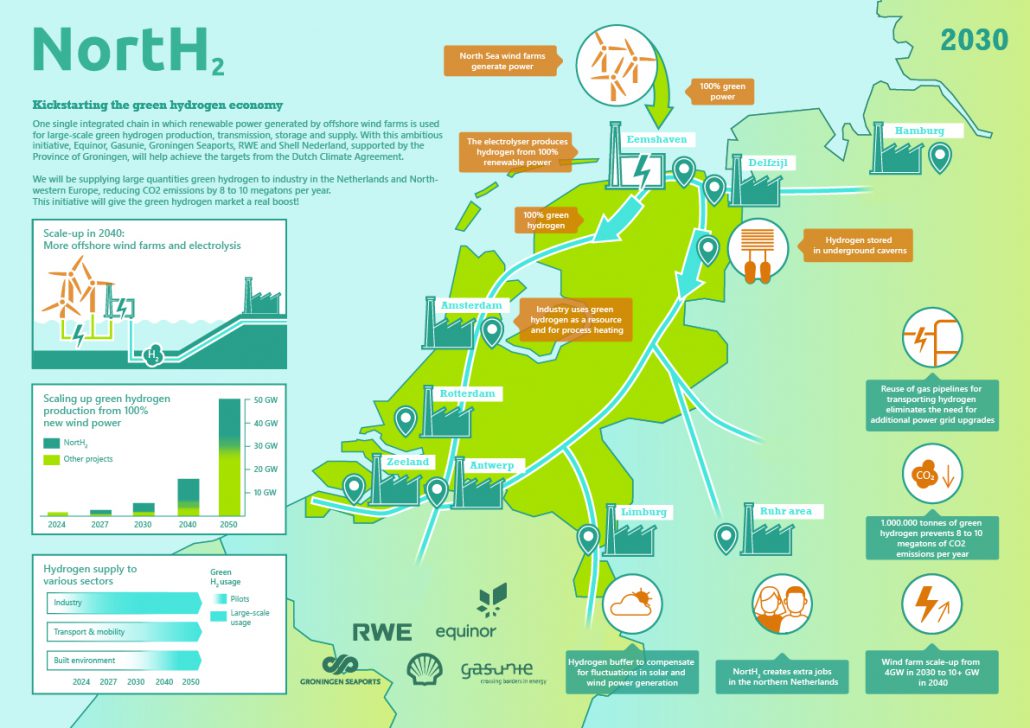Hydrogen
Hydrogen
Groningen Seaports strongly advocates scaling up the production of green hydrogen.
Dozens of hydrogen projects are already under development in the northwest of the Netherlands, many of which are planned in the port of Delfzijl and Eemshaven. Examples include the construction of electrolysers and hydrogen plants, the creation of specific port facilities, the development of a plastic pipe system (‘backbone’), but also the use of hydrogen in public transport and the development of hydrogen filling stations. We are also seeing a pressing need for new applications in the hydrogen ecosystem. Groningen Seaports is therefore fully committed to innovation and offers space and facilities for test centres, start-ups, scale-ups, pilot and demo plants.
Versatile energy carrier
Hydrogen (H2) is an energy carrier with a wide range of applications. Not only for the ports, but also for the entire region, including the city of Groningen. To give just a few examples, green hydrogen can be used as a transport fuel, for households, for industry, as a sustainable industrial raw material and as energy storage to replace batteries. It will soon be possible to produce, import, store and transport green hydrogen in Delfzijl and Eemshaven. It is also processed as a raw material into other products, such as synthetic fuels, plastics and fertilisers.

GERWIN MENNEGA
business manager hydrogen
E-mail address: g.mennega@groningen-seaports.com
Phone number: +31 (0)65 555 9044
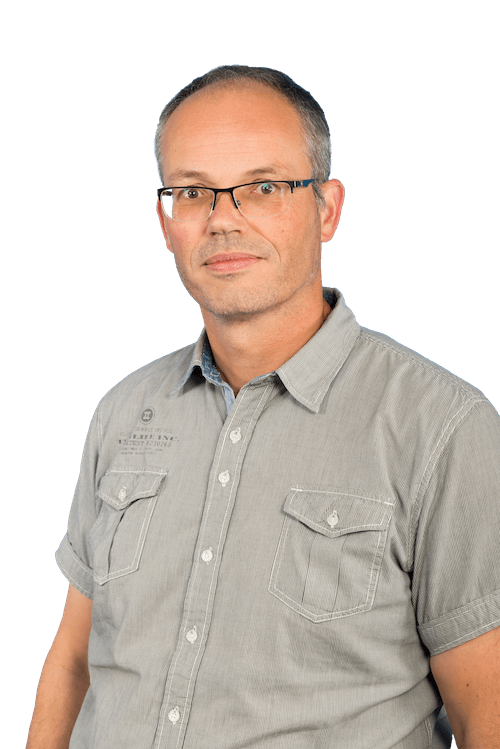
HERBERT COLMER
program manager
Email address: h.colmer@groningen-seaports.com
Phone number: +31 (0)65 197 8001
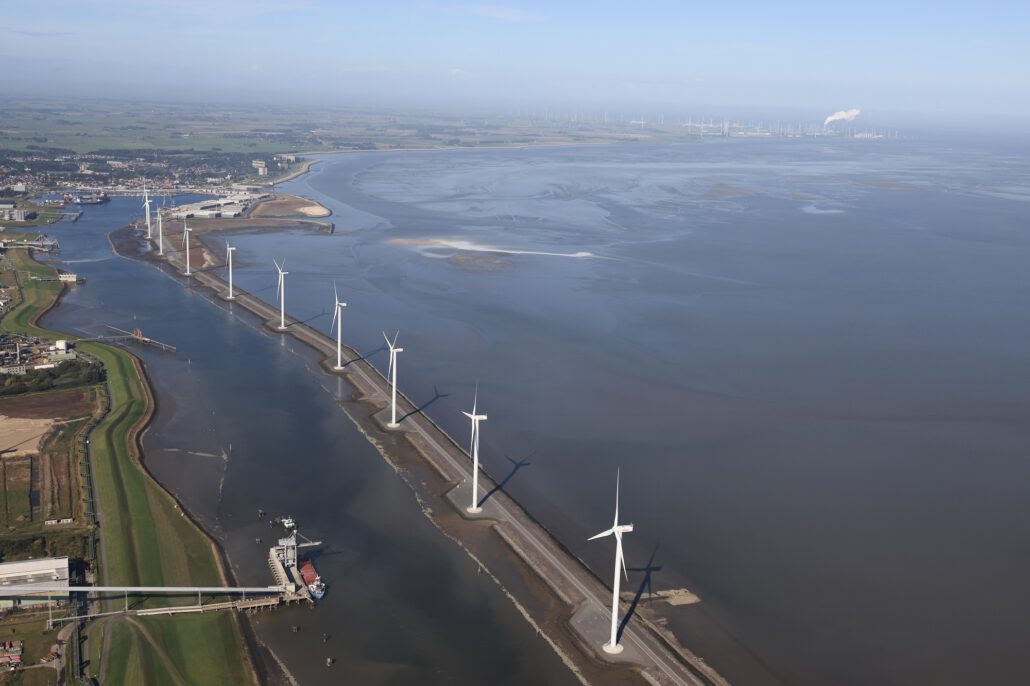
Unique hydrogen ecosystem
The Northern Netherlands is uniquely positioned to become Europe’s leading hydrogen ecosystem
In recent years, the Northern Netherlands has been fully committed to the development of hydrogen ecosystems. This has gained the region European recognition (FCH JU), and it is now acknowledged as the leading Hydrogen Valley in Europe: a fully-developed ecosystem of green hydrogen, from its production and transmission to its use in industry, mobility and the built environment. The unique characteristics of the northern parts of the Netherlands have contributed to this achievement. The region offers great potential for large-scale wind energy and has sufficient production locations. The gas infrastructure is already in place and the region has both access to the market and knowledge of and experience with the transmission of gases and the trade in these.
In summary: why Northern Netherlands?
1. Offshore wind potential North Sea (windy and undeep)
2. Sufficient space for electrolysers (in both port areas)
3. Local use (industry Delfzijl and Emmen)
4. Densest gas network in the world (redundant)
5. Storage Zuidwending (salt caverns)
6. Education | mbo/hbo/wo (universities/schools well-equipped)
HyNorth
HyNorth is all about the North as a frontrunner of the hydrogen economy. We are there for companies, knowledge institutions, governments and other hydrogen stakeholders in the Northern Netherlands.
Setting up a hydrogen economy is something no one can do alone. The challenges faced by an individual business are complex and time-consuming. HyNorth will be responding to this by acting as the supply chain director, supported by the regional business community, governments, and knowledge institutes, to develop hydrogen chains in the Northern Netherlands.
What hydrogen initiatives are there in the Northern Netherlands? Which parties are involved? How is the hydrogen ecosystem developing in the Northern Netherlands? These are all questions HyNorth can help with. Our active portfolio management activities enable us to share the latest insights and developments in the field of hydrogen in the Northern Netherlands.
More information?
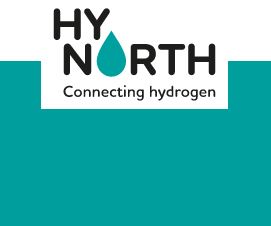
NortH2
Large-scale green hydrogen production
NortH2 wants to produce as much as 4 gigawatts of green hydrogen by 2030, which will fulfil one of the goals set by the Dutch Climate Agreement. But the ambition goes further than that. NortH2 wants to upscale to more than 10 gigawatts by 2040. By then, green hydrogen output, which will initially be produced in Eemshaven and later possibly offshore as well, will total around one million metric tons on an annual basis, cutting carbon emissions by over eight to ten megatons a year. The consortium, consisting of Gasunie, Groningen Seaports, Shell Nederland, Equinor and RWE, has the support of the Groningen provincial authority and does not rule out other serious partners joining the project further down the line
First of all, NortH2 provides for the construction of enormous wind farms in the North Sea, which could gradually grow to a final capacity of some 10 gigawatts (the electricity consumption of approximately 12.5 million Dutch households). The plan also covers a large electrolyser in Eemshaven, where wind energy will be converted into green hydrogen. Finally, a smart transport network is needed in the Netherlands and North-Western Europe to bring the 800,000 tonnes of green hydrogen mainly to industry, but later possibly also to the consumer. The first wind turbines could be ready as early as 2027 and be used for green hydrogen production.
More information?
Hydroports
The hydrogen hub of Europe
The Dutch energy supply is to be almost completely carbon neutral by 2050. This ambition in the Climate Agreement calls for a well-considered transition to a sustainable energy system and a circular industry. Emission-free energy carriers, together with direct use of green electricity, play a crucial role in this. Green hydrogen is an indispensable link in this chain. After all, green hydrogen can be used both as an energy carrier and as an industrial raw material. Moreover, the existing Dutch natural gas infrastructure is relatively easy to render suitable for the storage and transport of hydrogen. The seaports of Amsterdam, Den Helder and Groningen have joined forces to accelerate the development of the hydrogen system in the northwest of the Netherlands. Together they are positioning themselves under the name Hydroports, the hydrogen hub of Europe.
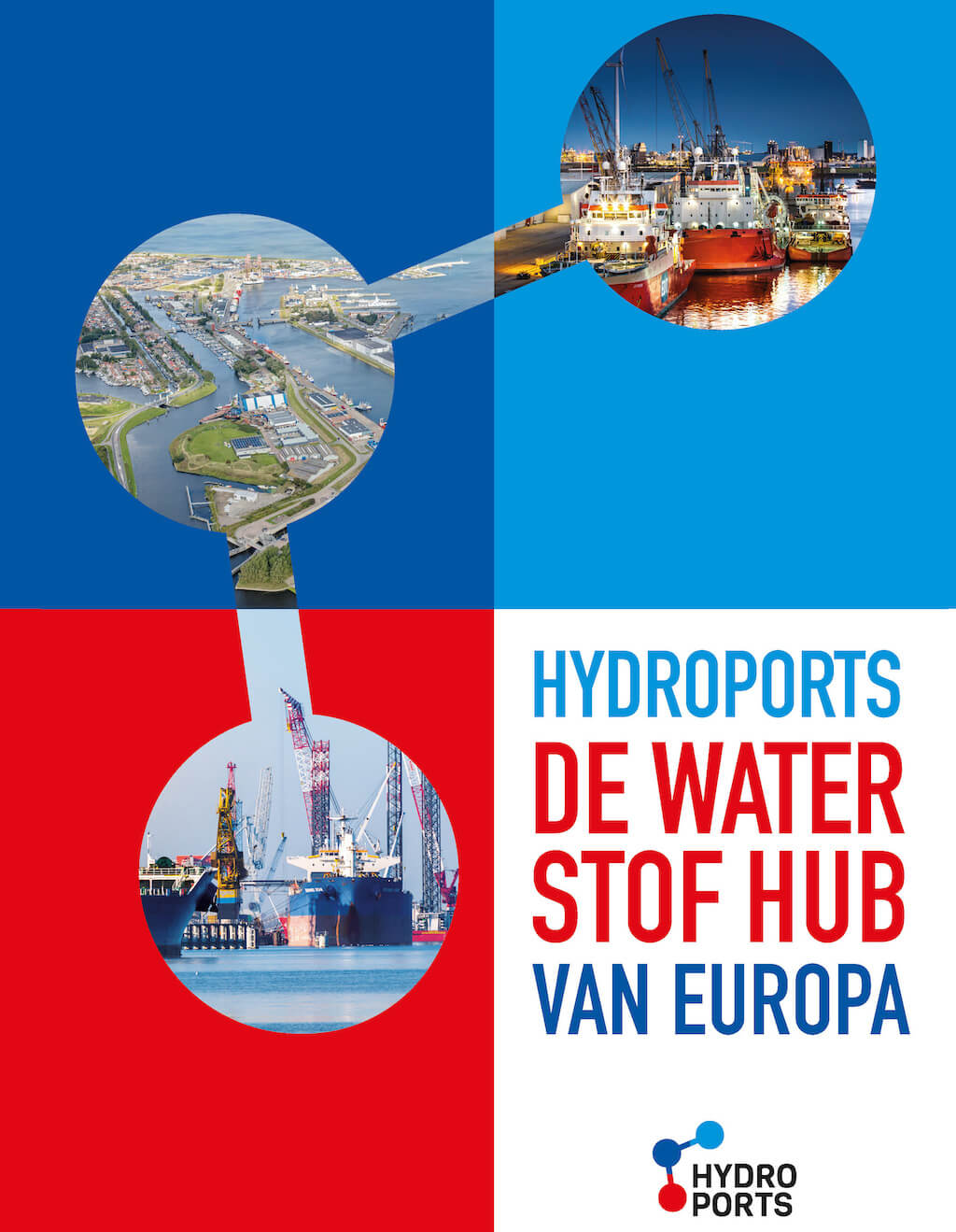
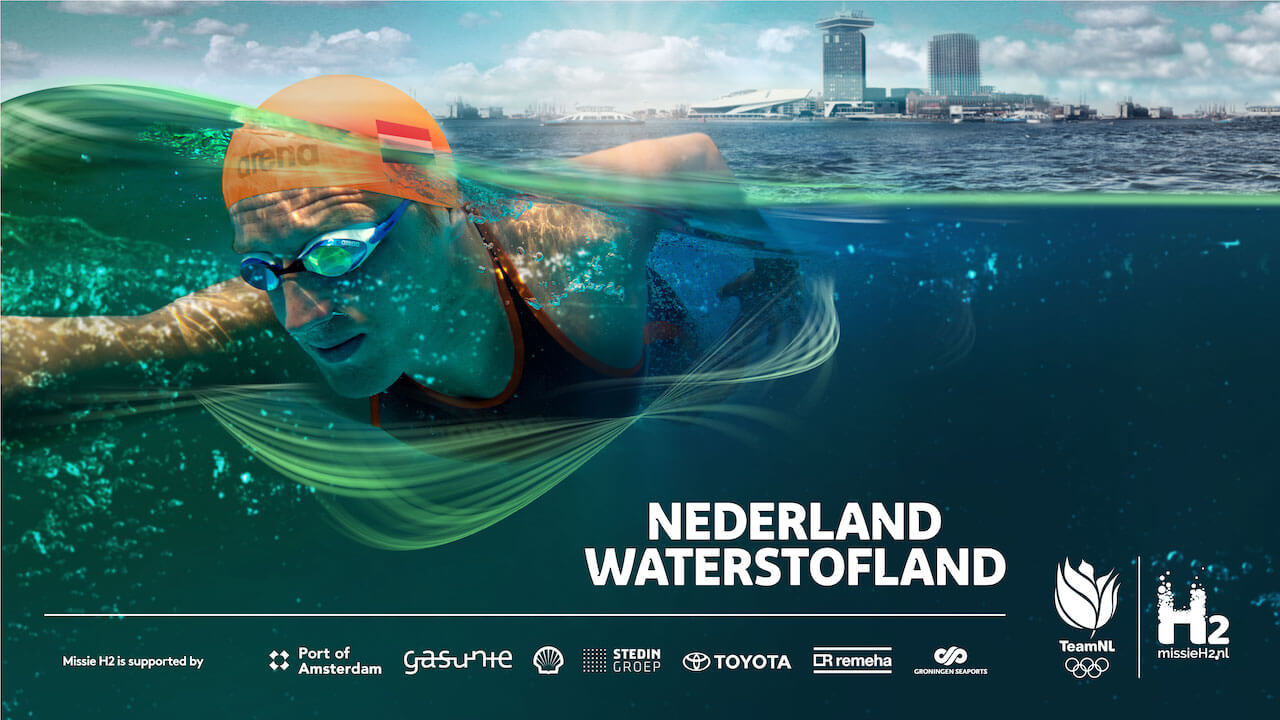
Mission H2
The Netherlands Hydrogen land – Working together to raise awareness of hydrogen
Groningen Seaports is promoting hydrogen as a sustainable energy carrier in partnership with Gasunie, Shell, Remeha, Stedin, Toyota, Port of Amsterdam and the Dutch Olympic Team (TeamNL). The aim of the companies is to increase awareness of the sustainable potential of hydrogen among the Dutch public and to promote concrete hydrogen projects and initiatives.
The timing is ideal: hydrogen occupies an important place in the Dutch climate agreement, and initiatives are emerging all around us. And that’s not all: Japan is profiling the 2021 Olympic Games as the ‘Hydrogen games’: hydrogen will provide the games with energy.
See the website of Mission H2 for more information.
Hydrogen backbone Delfzijl
Hydrogen (H2) offers a solution to the fluctuations in the supply of renewable energy, which is dependent on sun and wind. At Chemie Park Delfzijl the demand for hydrogen is rising, both from established companies and companies considering establishing themselves in the Delfzijl industrial park. The capacity of Nouryon’s existing H2 production is not sufficient to meet this demand. Together with Gasunie, Nouryon is developing a 20 MW electrolyser (Djewels 1) to expand the production capacity. Groningen Seaports is actively involved in this and is responsible for the pipeline system that will transport this H2 within the Chemiepark. Together with Soluforce, Groningen Seaports has developed a plastic hydrogen pipeline that could significantly reduce the costs of transporting hydrogen. The planned hydrogen infrastructure route initially runs from the newly built hydrogen plant Djewels 1 on the Nouryon site, parallel to the dike to BioMCN. A facility will be built near Teijin for a future connection, and the end of the pipeline will also be built in such a way that it can easily be extended in the future. Concrete plans for this are already being made with the construction of a second electrolyser, the arrival of a sustainable aviation fuel plant (SkyNRG), the development of the Heveskes business park and the area south of the Oosterhornkanaal. The hydrogen backbone will be expanded in phases so that all these areas can be connected to each other and all the players at Chemie Park Delfzijl can make optimum use of the available H2.
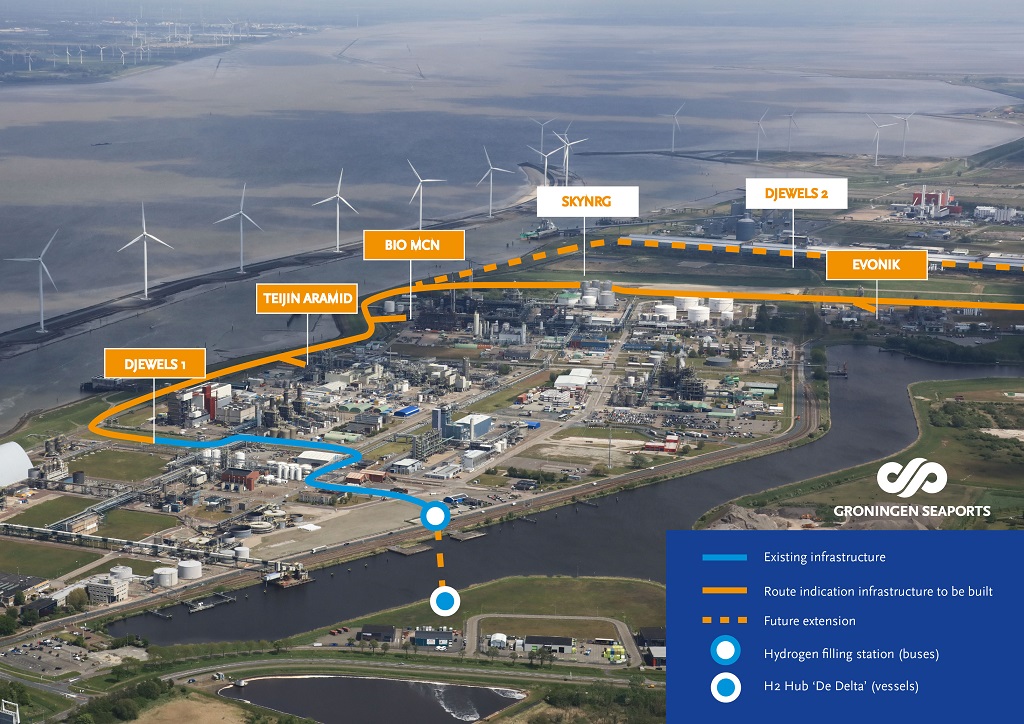
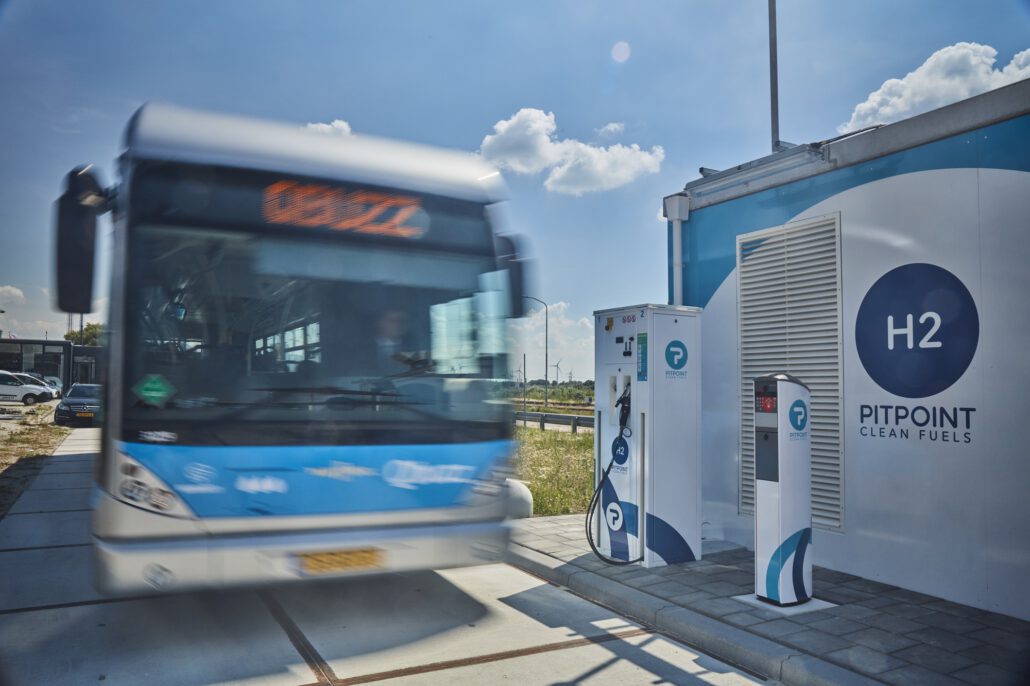
Hydrogen refuelling station PitPoint Delfzijl
The hydrogen refuelling station has been built and is operated by PitPoint clean fuels. Nobian (former AkzoNobel) supplies PitPoint with hydrogen by pipeline. The hydrogen is a by-product from Nobian’s chlorine production, produced sustainably by electrolysis, using electricity produced from wind energy. The hydrogen is therefore renewable and green, which is unique for the Netherlands. The refuelling station is located at the Chemie Park in Delfzijl, right next to the Nobian production plant. The Delfzijl refuelling station is PitPoint’s second hydrogen refuelling station development in Europe.
The Delfzijl refuelling station has been developed through an innovative public-private partnership between the OV-bureau for Groningen Drenthe, Qbuzz, Nobian, Groningen Seaports, PitPoint, the Dutch Ministry of Infrastructure, Public Works and Water Management, and the province of Groningen.
The refuelling station services the two fuel cell electric buses currently operated between Delfzijl and Assen by Dutch bus operator QBuzz. The two Van Hool fuel cell electric buses are operated as substitutes to standard diesel buses. The refuelling station is located close to the QBuzz bus depot, ensuring a smooth and efficient operation of the buses on a daily basis.
Hydrogen for shore power
Groningen Seaports is involved in a project in which a hydrogen-based mobile fuel cell generator will be designed and tested to supply shore power in the port of Delfzijl and Eemshaven. As well as Groningen Seaports, Port of Den Helder and Port of Harlingen are also working on this project. The technology will be developed and applied by Eekels Technology, Nedstack Fuel Cell Technology and Bredenoord, with support from FME. This project will prevent carbon and nitrogen emissions and noise nuisance. The ship’s engines can be shut down as soon as a ship is moored because electricity required for the hotel function can then be supplied via a mobile fuel cell generator. The mobile fuel cell generator, in addition to being used as a mobile shore-based power unit, is ultimately expected to meet the temporary demand for electricity at construction sites and events, for example.
Wadden Fund
One of the investors in the ‘hydrogen for shore power’ project is the Wadden Fund. In fact, it is the first project of a total of ten sub-projects, the first five of which will be running until 2024. This forms part of an extensive investment programme in making shipping on the Wadden Sea more sustainable under the name Green Shipping. The Wadden Fund contributes a total of € 8 million to this. The Green Shipping project aims to make the Wadden fleet largely sustainable in ten years’ time. This should result in carbon emissions being reduced by 60% by 2030. The total investment for Green Shipping over the next four years amounts to € 26 million.
